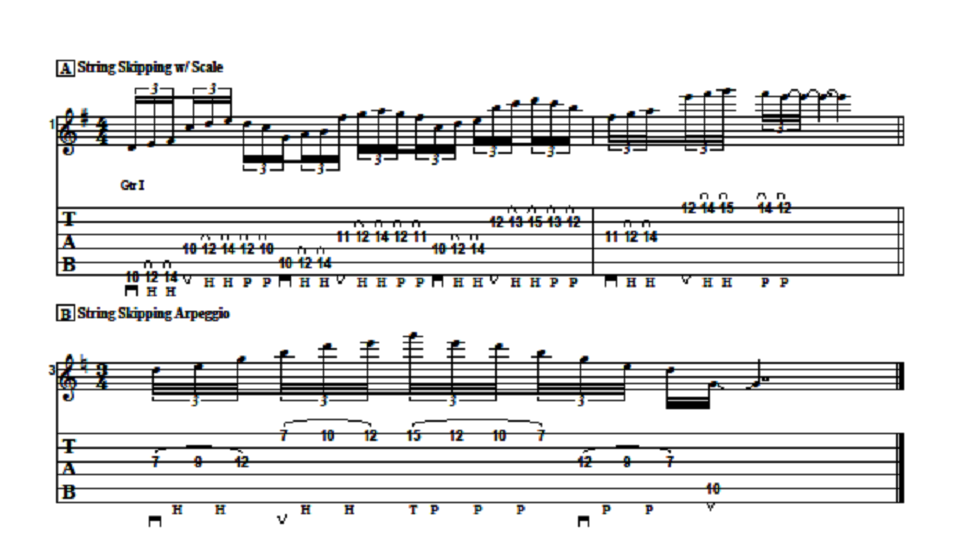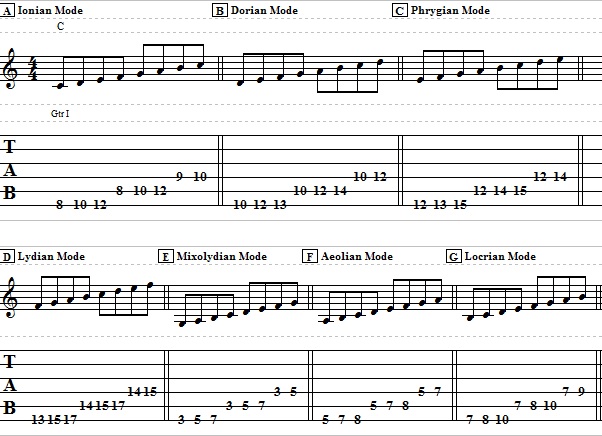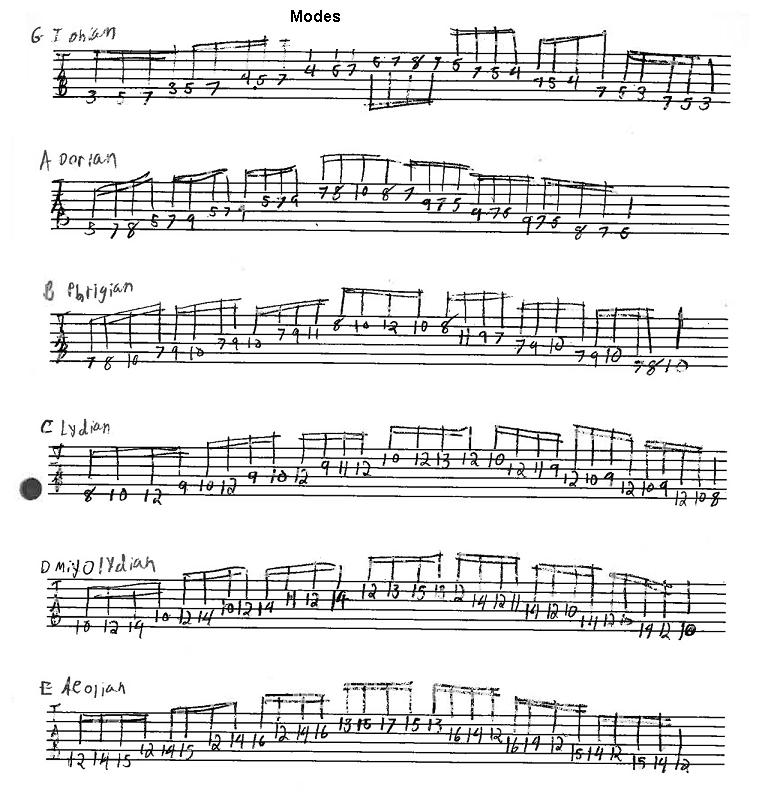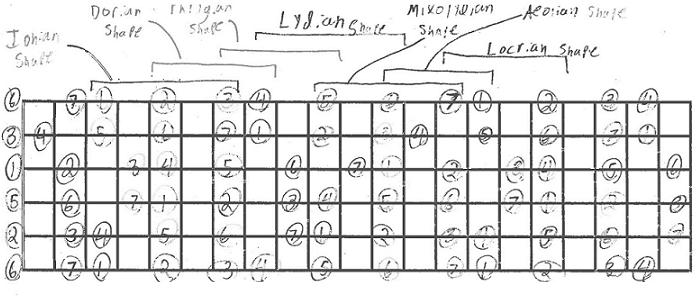Hey, it’s Claude Johnson here and I want to give you
a super fast, super easy crash course on modes. A lot
of guitarists get confused by modes. They think it’s
some complicated thing. And there are a lot of
sophisticated ways to use modes, but the basic concept
is really simple.
So let’s start with understanding what a scale is.
A scale is a collection of notes. For example, C-major
has the notes C, D, E, F, G, A and B. And then it
repeats going back to C and going up another octave.
Now, it doesn’t matter if you play it like that.
Or you can play it three notes per string like this.
We don’t care about that for now. What we do care
about is the intervals. Let’s try to play a C-major
scale on the A string, just all on one string, 3rd fret.
We’re going to go… Just so we can see it laid out.
As you can see, there’s different intervals. When we
start from a C to a D, is two frets, which is called
a whole step. Another whole step, D to E. We have one
fret, which is called a half step, E to F.
Then after, G. whole step. G to A, whole step. A to B,
which is a whole step and then finally, one more half step.
By playing it that way you can see that the notes have
a very specific interval pattern, which is whole step,
whole step, half step, whole step, whole step, whole step,
half step. Now, we can repeat that anywhere on the neck
starting at any note.
So with the C, remember… We played this shape. We can
move this shape down to here and then we have the same —
we’re just starting on a different fret, but we have the
same pattern on the fret board and it’s also the same
intervals, whole step, whole step, half step, whole step,
whole step, whole step, half step.
As you can hear, it sounds pretty much the same. It’s got
a different flavor a little bit because it’s A, a little
bit warmer flavor, but it’s still the same basic character.
Now, that’s the major scale. That’s all about intervals.
Now let’s just go back to our C scale. We’re going to
play the same notes in the C scale, but we’re gong to
emphasize or land on a different note.
Instead of our C, let’s take our A and we’ll play all
the same notes but we’ll just kind of start and end on
that A. That’s actually called A-minor even though it’s
got the same notes as the C-major scale, because we’re
emphasizing that A note. It becomes A-minor.
So when you’re learning a scale all over the fret board,
it’s true that you only really have to learn one pattern.
Now, of course, C-major will be a different pattern all
over the neck than G-major, but C-major would be the same
all over the neck as A-minor.
Each of the notes of the scale, C, D, E, F, G, A and B,
would be a different mode if you started in that mode.
So think of it as an inversion of a scale. Just like we
have a chord, you have your C chord, you could play
inversion of a C, but you’re in a little bit different
position. Those are chord inversions. A scale inversion
is a mode.
The first mode is ionian, starting out with C. The next
mode is dorian, starting on the 2nd degree, which in this
case is D. The third mode if frigian, starting on the 3rd
degree. The third mode is phrygian, starting on the 3rd
degree. The fourth mode is lydian, starting on the F.
The fifth mode is called mixolydian, starting with the
5th degree, or in this case, G. The sixth mode is called
aeolian or that’s also the minor, in this key, A-minor.
And finally, the seventh mode is called locrian, starting
on the 7th degree or the B.
The way I just played it, it all kind of sounds the same,
maybe, but each of these m modes has specific characteristics
and they can be used in all kinds of different musical
situations and contexts. So I just wanted to give you the basic
concept and next time we’ll go deeper into how to use some of
these modes.
Just to demonstrate the different characteristics, like this
major scale. I already showed you the major and minor.
The major… The minor… They all have different characteristics.
For example, the phrygian… And the lydian…Just a little bit
different characteristics, all the same notes, we’re just playing
C, D, E, F, G, A, B, but I’m emphasizing a different starting point
for that scale.
Okay, now there’s one more major piece to the puzzle and I think
this is where people get confused, and it has to do with playing
the same root, but with a different mode. So like C-major versus
C-mixolydian.
Remember, in the key of C-major your mixolydian mode comes on G,
which is the 5th degree. So you count out, C, D, E, F, G. So C-major…
Now, just like the C-major scale has a specific interval pattern,
whole step, whole step, half step, whole step, whole step, whole step,
half step, your mixolydian mode or any of the modes are going to have
a specific interval pattern as well.
The mixolydian happens to be whole step, whole step, half step, whole
step, whole step, half step, whole step. Instead of playing — like
G-major would be like this… That 7th note is a flatted note, so
instead of F-sharp you have F-natural.
We can take this little pattern and start it on the C and we’re just
basically using the same intervals, but we’re starting on the C note
with C mixolydian. If you look at the notes in C-mixolydian, remember
I said a flat 7th instead of the natural 7th. That’s the B, flat the
7th, that’s a B-flat. So C-mixolydian would have C, D, E, F, G, A,
B-flat and then C.
That’s actually the same notes in F-major. You could also count
down from your C — five, four, three, two, one — there’s your F.
So it’s like we’re in the key of F-major but we’re starting on the C.
Now, this might sound really strange if you’re going from C to
C-mixolydian. If we’re in C we’re established that sound in our
mind and then we go to the B-flat it sounds totally out, right?
But now, if we kind of play a C-7 we can start on that B-flat.
It sounds a little bit more normal.
That’s a C-7 arpeggio. So you can hear how that flatted 7th, it
goes perfectly with that dominant 7th chord.
Hey, it’s Claude Johnson here and let’s pick up right where we
left off last time, talking about modes. I gave you the basic
concept and also we talked about using different modes with
the same root, such as C-major versus C-mixolydian.
Now, let’s add one more piece to that puzzle and bring in the
pentatonic scale, our good friend the pentatonic scale, because
that’s always a good place to go and kind of relate to and link
things back to.
So let’s go to the key of D. We have our D pentatonic. And you
can create a lot of familiar sounds just by playing the notes
in that scale. You’ve got your basic pentatonic sound, right?
But now, we can add-in two extra notes, our E and our B-flat,
and we change that pentatonic scale to a minor scale. So before
we had this… Now we have this… Again, I’m not concerned
about patterns. You can play this anywhere you want, but I want
you to get the concept. You’re adding-in those two extra notes.
Just to give you one pattern, I mean, this is a root position
10th fret pentatonic. You add-in your E on the 9th fret of the
G string and you can add-in your B-flat on the 11th fret of
the B string. Pentatonic. Minor. So you can kind of hear how
that works, and maybe you’ve already done this.
But now, let’s try switching to D dorian. So instead of this…
We’ll have this. Again, try switching from pentatonic to dorian.
And then also try switching back and forth from minor, which is
aeolian, to dorian. Okay? Minor. Dorian. It’s just different ways
to experiment, but you’re still in D. Pentatonic. And then…
Minor. Dorian.





